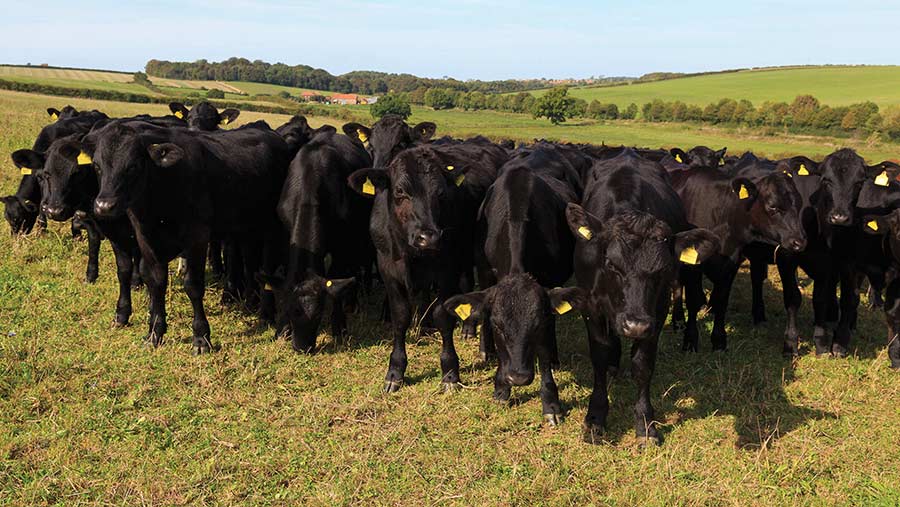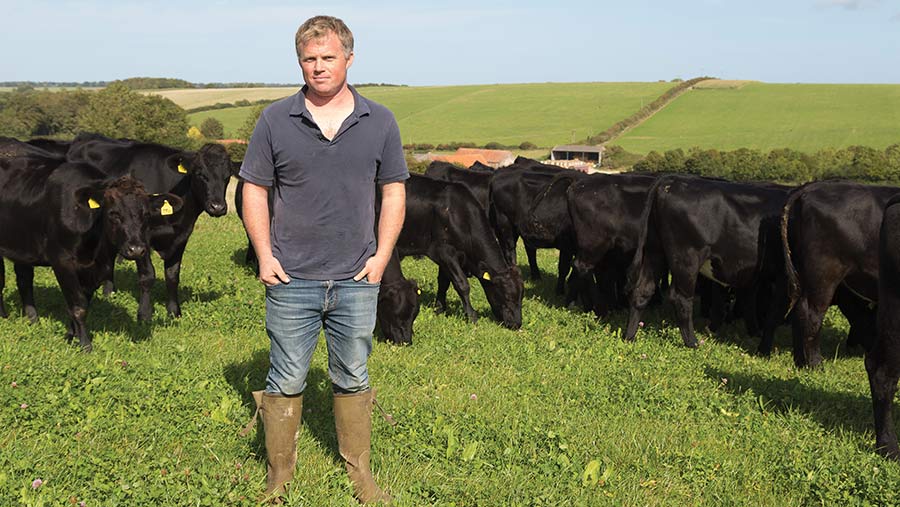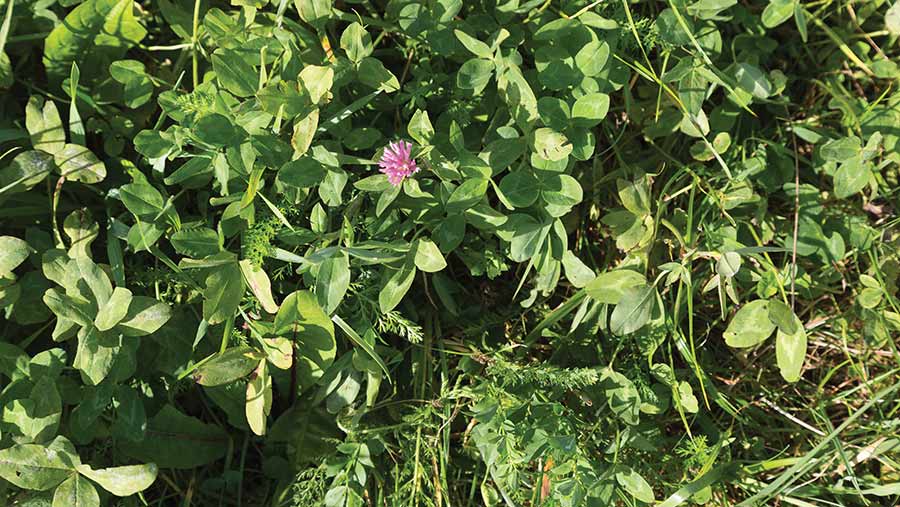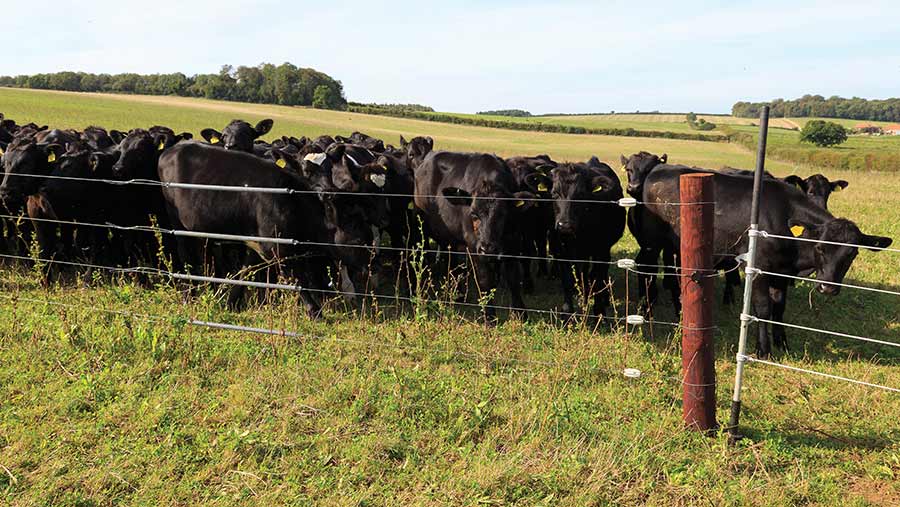Why dairy beef is set to beat arable returns
 © MAG/Judith Tooth
© MAG/Judith Tooth Grazing dairy beef cattle is proving more profitable than arable cropping on a north Norfolk farm. It is also the best way to improve soils, says David Cross, whose aim is to create a sustainable mixed farm.
At 2-3%, soil organic matter at Glovers Farm, in Sedgeford, is “typical, but bad”, and inherent fertility on the light, chalky soils is low. At the same time, having a sugar beet-based arable rotation means cultivations cannot be avoided.
With the phase-out of the single farm payment, David says he had limited options and time to improve his soils: “Post-2027, we would be one dry summer away from going out of business.”
See also: Tips on starting out in dairy beef production
Farm facts: Glovers Farm, north Norfolk
- AHDB sheep and beef monitor farm
- 360ha tenanted land on Sedgeford Hall estate
- Additional 57ha parkland grazing
- Multiplier flock for EasyRams, with 1,000 ewes and ewe lambs mated in 2022, increasing to 1,400 in next two to three years
- 360 dairy-beef cattle on GS4 herbal leys, with limited winter housing
- Sandy loam soils over chalk; dries out in summer
- Annual rainfall: 500-600mm
- Cereals, sugar beet, and potatoes (sub-let)

David Cross © MAG/Judith Tooth
Lowering fertiliser and agrochemical inputs would be difficult without a higher proportion of clay and more organic matter, he says. And the farm was already growing cover crops and using min-till and direct drilling.
Instead, David looked to livestock for the solution. “What’s the quickest way to improve soils? It’s multispecies leys and cattle on single-day moves,” he says.
Assessing the potential
Livestock consultant James Daniels, of Precision Grazing, modelled a dairy beef enterprise for the farm to establish the scale of operation, after allowing for the farm’s sheep flock.
The farm was already three years into a Countryside Stewardship (CS) agreement, which included growing GS4 herb- and legume-rich swards in the arable rotation.
Together with parkland on a neighbouring estate – managed as low-input grazing under CS, and 16ha (40 acres) of lucerne – James calculated this would give a total of 180ha (445 acres) of available pasture producing 1,330t dry matter (DM).
With 1,000 ewes (plus replacements) already using 650t DM (as well as 284t DM from cover crops), this left a potential 680t DM to support a new dairy beef enterprise.
James modelled the requirements for two groups of cattle with target daily liveweight gain of 1kg:
- Group one 120 calves arriving in January weighing 150kg and leaving in October at 450kg, with a total feed demand of 230t DM (supplied by 200t DM from pasture and 33t DM from lucerne silage)
- Group two 120 calves arriving in April and leaving in November at 340kg, with a total demand of 140t DM from pasture.
This would result in 75% utilisation of pasture; the remaining 25% would provide a buffer for a dry summer and build soil organic matter.
Predicted individual gross margins allocated to area were:
- Sheep enterprise – £1,053/ha
- January dairy beef – £864/ha
- April dairy beef – £809/ha.
The overall gross margin for the livestock enterprises, including GS4 payments, averaged across the 180ha grazing platform, was calculated at £1,154/ha.
Further benefits are from increased soil organic matter and fertility, carbon sequestration and business sustainability, James points out.
Getting started
David was introduced to Pathway Farming through beef and sheep consultant Liz Genever. Liz runs Carbon Dating, which matches farmers looking for livestock to improve soils with farmers trying to find suitable land for grazing.
Pathway is a dedicated supply chain for M&S. Scottish-born dairy cross Angus calves go to a calf rearing unit in Yorkshire.
They are then distributed at 150-160kg to grazier farms, where they spend at least 150 days grazing, before moving to dedicated finishing yards at 400kg.
David’s transition to dairy beef began last year with 90 calves. This year, he has taken three groups of 120 – in January, April and August.
The August group will graze until December before being housed for winter. They will leave next May, by which time two further groups will be on farm.
David uses the Breedr precision livestock app, provided by Pathway, to record data. “We are expected to maintain 0.8kg daily liveweight gain, but as we get paid on weight gained, our target is 1kg,” he explains.
Sheep netting, topped with a hot wire, provides the perimeter fencing, while high-tensile electric fences are used to split fields into wide alleyways.
Single poly-braided wires, hooked at each end, then divide the alleyways. Every alleyway has a water connection point, and on Mondays the week’s break fences are set out.

The herbal leys contain five grasses, four legumes and four herbs © MAG/Judith Tooth
Rollout
David’s current CS agreement is due to be cut short and replaced in January 2024. This will see all but 66ha (163 acres) of the farm in GS4 herbal leys. These must be rested for a 35-day period between 1 May and 31 July.
“That’s easy to achieve with cattle on a minimum 35-day grazing rotation,” says David.
“We won’t be buying fertiliser or chemicals, the cattle are contract reared, and we know the price before we start. Also, 90% of the cattle won’t have to overwinter, so we need very little silage.”
Compared with the predicted gross margins, beef figures are fairly on par, he says, as the only variable really is growth rate – area and price are fixed.
“Growth rate is slightly under, but we’re still learning, especially about allocation of grass and use of concentrates [at transition]. The livestock gross margin is better than everything but sugar beet, which is predicted to be £1,731/ha this season.
“Our wheat gross margin was £693 and spring barley was £747, and with weather and market variation, we could easily be making a loss.”

High-tensile electric fences will be replaced with permanent fencing either side of new hedges this winter © MAG/Judith Tooth
Further development
From 2025, he plans to increase cattle numbers to about 800, with most delivered in March to make use of the better-quality grazing in spring, and one group delivered in August to manage the parkland.
Once the transition is complete, he anticipates half to three-quarters of the farm being in GS4 and a quarter to half of the farm in arable.
This winter, permanent electric fencing, funded through CS capital works, will replace the high-tensile wires. This will be erected either side of new hedges, planted to create 90m or 120m paddocks.
“We’re investing in infrastructure so we can run with a smaller labour requirement,” says David, who farms with father John and part-time worker Alex Lockhart.
He is still debating how best to integrate cattle and sheep on the farm, but is leaning towards a leader-follower approach, with sheep and lambs followed by cattle.
“We need to preferentially graze lambs to ensure they get good-quality grass and maintain growth rates to get them off the farm as soon as possible.”
The numbers
- 13: Number of species in herbal leys
- 1: Total worm count in 10 pits dug after sugar beet and potatoes
- 32: Number of worms/spade found in simple, four-year herbal ley
- £382: Payment/ha for GS4 herbal ley
